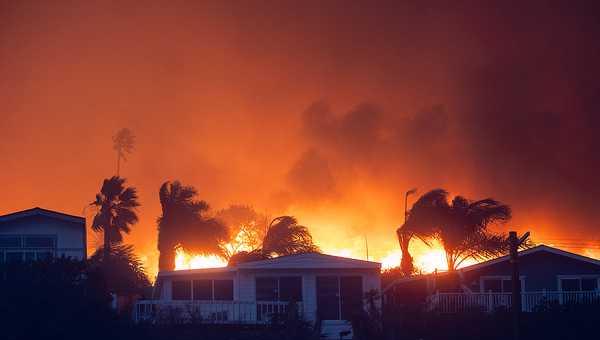Hollywood Hills Fire Crisis: Natural Forces and Human Response
A devastating wildfire in Los Angeles has destroyed 1,000 buildings and forced over 100,000 evacuations. The Santa Ana winds, combined with dry conditions, have created unprecedented challenges for firefighting efforts in this affluent area.

The recent wildfire ravaging Los Angeles’s affluent neighborhoods represents one of the most destructive blazes in the city’s history. The fire’s rapid spread and intensity can be attributed to several key factors that have created a perfect storm of dangerous conditions.
The Santa Ana winds, a meteorological phenomenon unique to Southern California, have played a crucial role in this disaster. These powerful northeastern winds, which can exceed force 8 on the Beaufort scale, travel down coastal mountain ranges and become increasingly hot and dry. When combined with existing fire sources, they create ideal conditions for rapid fire spread, particularly in drought conditions.
The timing of this disaster is particularly significant. According to the National Weather Service, Los Angeles experienced one of its driest periods on record from May to December 2024, with the central city recording only 4.06mm of rainfall. This extreme drought has created extraordinarily vulnerable conditions in the region.
The fire’s impact on Hollywood Hills, particularly the Palisades area where home values average $3.5 million, has been catastrophic. The destruction of approximately 1,000 buildings represents an estimated direct loss of $23.6 billion. This area, home to many entertainment industry professionals and luxury residences, has seen some of its most iconic landmarks along Sunset Boulevard severely damaged or destroyed.
The firefighting response has faced significant challenges. Unlike similar incidents in other regions where massive mobilization is possible, Los Angeles County has been limited to approximately 1,500 firefighters, including volunteers. This relatively small force must handle both fire suppression and evacuation duties across a large urban-wildland interface.
The disaster has sparked broader discussions about climate resilience and urban planning in high-risk areas. The presence of luxury homes in fire-prone zones, coupled with complex insurance implications, raises questions about sustainable development in these regions. Private firefighting forces, hired by insurance companies and wealthy homeowners, have added another layer of complexity to the emergency response.
The air quality impact has been particularly notable. In the early morning hours, burning polymer particles have created an eerie orange sunrise over Los Angeles, with particle sizes matching the wavelength of red-orange light causing Mie scattering - a phenomenon that has created apocalyptic-looking scenes across the city.
This event may significantly impact California’s tourism industry, particularly in affected areas like Oxnard. The combination of environmental damage and infrastructure loss could have long-lasting effects on the region’s economy and community structure.
Emergency response efforts continue with support from federal resources, following President Biden’s approval of a Major Disaster Declaration. This designation enables federal funding assistance for temporary housing, home repairs, and recovery efforts for affected residents and businesses in Southern Los Angeles County.